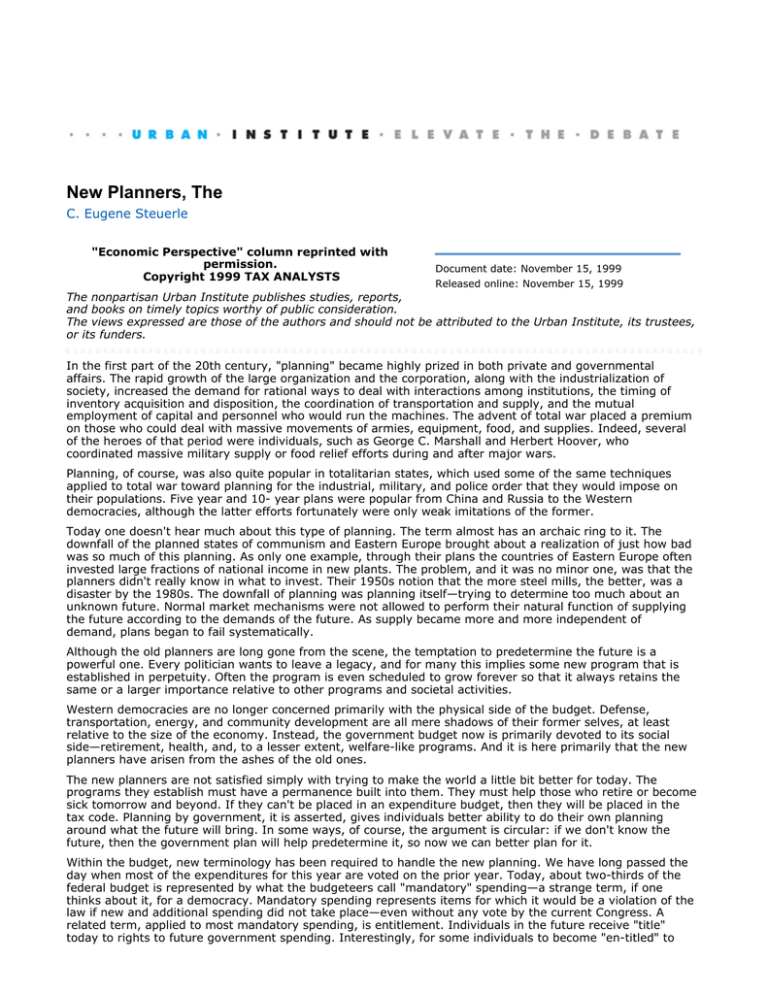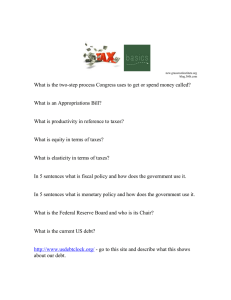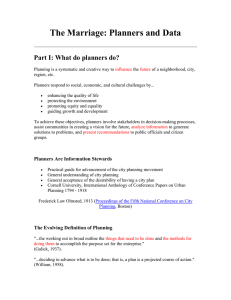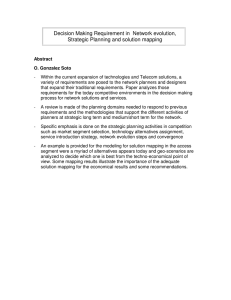New Planners, The C. Eugene Steuerle
advertisement

New Planners, The C. Eugene Steuerle "Economic Perspective" column reprinted with permission. Copyright 1999 TAX ANALYSTS Document date: November 15, 1999 Released online: November 15, 1999 The nonpartisan Urban Institute publishes studies, reports, and books on timely topics worthy of public consideration. The views expressed are those of the authors and should not be attributed to the Urban Institute, its trustees, or its funders. In the first part of the 20th century, "planning" became highly prized in both private and governmental affairs. The rapid growth of the large organization and the corporation, along with the industrialization of society, increased the demand for rational ways to deal with interactions among institutions, the timing of inventory acquisition and disposition, the coordination of transportation and supply, and the mutual employment of capital and personnel who would run the machines. The advent of total war placed a premium on those who could deal with massive movements of armies, equipment, food, and supplies. Indeed, several of the heroes of that period were individuals, such as George C. Marshall and Herbert Hoover, who coordinated massive military supply or food relief efforts during and after major wars. Planning, of course, was also quite popular in totalitarian states, which used some of the same techniques applied to total war toward planning for the industrial, military, and police order that they would impose on their populations. Five year and 10- year plans were popular from China and Russia to the Western democracies, although the latter efforts fortunately were only weak imitations of the former. Today one doesn't hear much about this type of planning. The term almost has an archaic ring to it. The downfall of the planned states of communism and Eastern Europe brought about a realization of just how bad was so much of this planning. As only one example, through their plans the countries of Eastern Europe often invested large fractions of national income in new plants. The problem, and it was no minor one, was that the planners didn't really know in what to invest. Their 1950s notion that the more steel mills, the better, was a disaster by the 1980s. The downfall of planning was planning itself—trying to determine too much about an unknown future. Normal market mechanisms were not allowed to perform their natural function of supplying the future according to the demands of the future. As supply became more and more independent of demand, plans began to fail systematically. Although the old planners are long gone from the scene, the temptation to predetermine the future is a powerful one. Every politician wants to leave a legacy, and for many this implies some new program that is established in perpetuity. Often the program is even scheduled to grow forever so that it always retains the same or a larger importance relative to other programs and societal activities. Western democracies are no longer concerned primarily with the physical side of the budget. Defense, transportation, energy, and community development are all mere shadows of their former selves, at least relative to the size of the economy. Instead, the government budget now is primarily devoted to its social side—retirement, health, and, to a lesser extent, welfare-like programs. And it is here primarily that the new planners have arisen from the ashes of the old ones. The new planners are not satisfied simply with trying to make the world a little bit better for today. The programs they establish must have a permanence built into them. They must help those who retire or become sick tomorrow and beyond. If they can't be placed in an expenditure budget, then they will be placed in the tax code. Planning by government, it is asserted, gives individuals better ability to do their own planning around what the future will bring. In some ways, of course, the argument is circular: if we don't know the future, then the government plan will help predetermine it, so now we can better plan for it. Within the budget, new terminology has been required to handle the new planning. We have long passed the day when most of the expenditures for this year are voted on the prior year. Today, about two-thirds of the federal budget is represented by what the budgeteers call "mandatory" spending—a strange term, if one thinks about it, for a democracy. Mandatory spending represents items for which it would be a violation of the law if new and additional spending did not take place—even without any vote by the current Congress. A related term, applied to most mandatory spending, is entitlement. Individuals in the future receive "title" today to rights to future government spending. Interestingly, for some individuals to become "en-titled" to future spending, other individuals must become "un-en-titled" individually to the product of their own saving and labor, and collectively to the right to determine how to spend government revenue to which they have contributed. That is, they must be taxed to support spending for which neither they nor their elected representatives have voted. That need to decide has been taken away by the new planners. Where there once were 5-year plans and 10-year plans, today we see cropping up 5-year budgets and 10-year budgets, and 75- year projections of actuarial balance. Some fault the estimators for trying to guess—and guess is all they can do—how much is promised for the future. But this is looking at the situation upside- down. It is the plan that requires the estimate, not the estimate that requires the plan. Among both Republicans and Democrats today, it is well recognized that something has gone awry. Long-term projections show that retirement and health systems are out of balance. But most proposed solutions don't get to the heart of the problem at all. The political debate is mainly over who will do the planning, not whether the planning itself is excessive. For the long-term, we are told that our main concern should be whether we should replace Democratic planning with Republican planning, or vice-versa. For the intermediate term, the plans of both parties would actually increase, not decrease, the percentage of spending or revenues that are devoted to mandatory spending. Don't misunderstand me. Not all planning is bad. When planning is rampant, moreover, it often can be countered only with systematic planning on how to restore balance. Herbert Hoover had to plan how to provide food relief after World War I and George Marshall had to plan on how to insure adequate supply to the troops. But their largest- scale plans were not for decades in the future, and they were required largely to deal with the threats of hunger and conquest that were the consequences of other failed planners. Thus, despite some exceptions, future demands must largely be allowed to determine what is supplied in the future. The failure of government today is too much planning, not too little. The new planners have failed, just as did the old ones. Whatever their good intentions, they trust too little in the ability of the people—whether individually or collectively as voters—to determine more of their own future. They have planned for failure. Other Publications by the Authors C. Eugene Steuerle Usage and reprints: Most publications may be downloaded free of charge from the web site and may be used and copies made for research, academic, policy or other non-commercial purposes. Proper attribution is required. Posting UI research papers on other websites is permitted subject to prior approval from the Urban Institute—contact publicaffairs@urban.org. If you are unable to access or print the PDF document please contact us or call the Publications Office at (202) 261-5687. Disclaimer: The nonpartisan Urban Institute publishes studies, reports, and books on timely topics worthy of public consideration. The views expressed are those of the authors and should not be attributed to the Urban Institute, its trustees, or its funders. Copyright of the written materials contained within the Urban Institute website is owned or controlled by the Urban Institute. Source: The Urban Institute, © 2012 | http://www.urban.org





